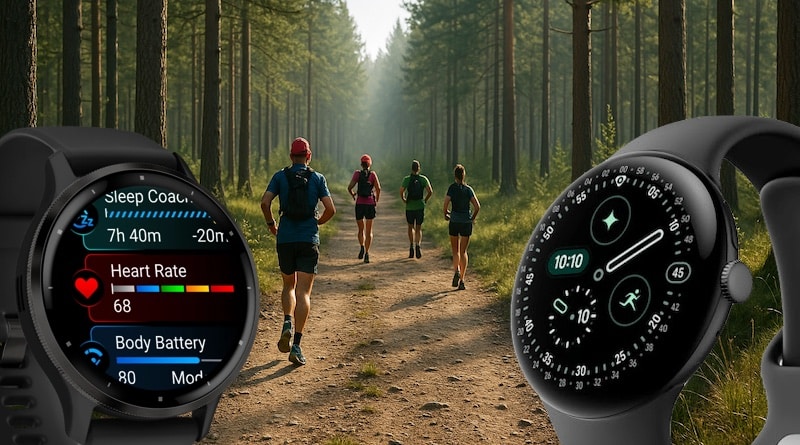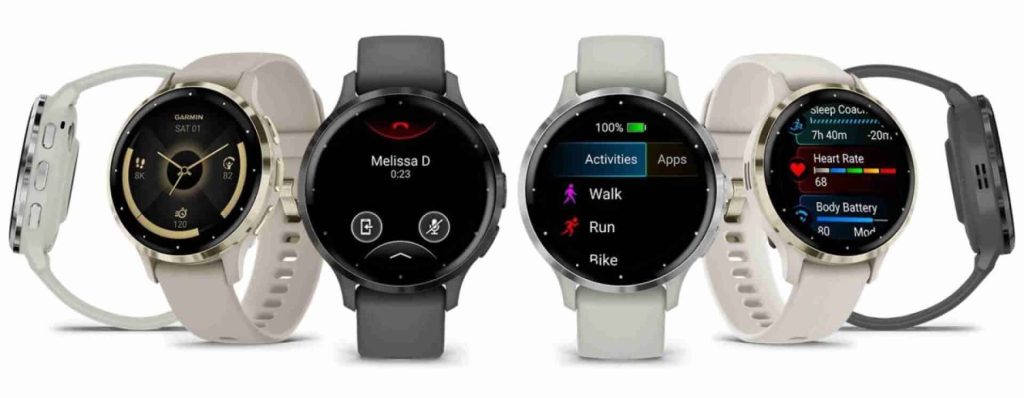
Inside the trade-offs of Google Pixel Watch 4 vs Garmin Venu 3
The Pixel Watch 4 is the latest generation Google timepiece. Garmin Venu 3, on the other hand, has now been on the market for two years. And while signs of a Venu 4 are emerging, nothing concrete has landed. Just a single reference on Garmin’s website that has now been deleted.
That makes this an interesting moment for a comparison. Pixel Watch 4 arrives with lots of fan-fare. Venu 3, meanwhile, sits in a kind of limbo. It is still widely available and fully supported, but clearly approaching the end of its retail cycle. Until Garmin officially unveils the Venu 4, this is still the match-up most buyers will be deciding between.
Premium materials, different intentions
Google’s Pixel Watch 4 continues the domed glass design, wrapping into a 100 percent recycled aluminium case. It comes in 41mm and 45mm sizes, just like Pixel Watch 3 before it. Navigation is handled through a digital crown and a single button. It’s compact and curved, designed for subtlety and style. Actually, not too different from the predecessor version.

Garmin’s Venu 3 also offers two sizes, Venu 3 (45mm) and Venu 3S (41mm). But it’s built for practicality. The stainless steel bezel frames a flat AMOLED display, and the watch includes three buttons for physical navigation. That extra input helps when you’re mid-run, in the pool, or just want reliability under pressure. But you don’t get a physical crown.

AMOLED tech with different goals
As far as display, Google Pixel Watch 4 brings a brighter, more responsive screen. The Actua 360 display can hit 3000 nits and uses LTPO tech to vary refresh rates between 1Hz and 60Hz. This improves fluidity while helping preserve battery when the screen is idle. It also has a 10% larger viewing area than its predecessor.
Venu 3 doesn’t match those specs, but it’s still AMOLED, clear, and sunlight-readable. The difference comes down to polish versus endurance. Google Pixel Watch 4 offers better visuals. Venu 3 offers better efficiency.
Sensors and GPS accuracy
Both of these devices are packed with sensors. The ones that can be found on Pixel Watch include ECG, skin temperature, cEDA for continuous stress tracking, red and infrared SpO2, and a multipath optical heart rate sensor. It also has a compass, barometer, altimeter, magnetometer, ambient light sensor, and dual-band GPS with support for Glonass, Beidou, Galileo and QZSS.
That dual-band positioning should offer more accurate location tracking in tough signal environments like cities or wooded trails. It is one of the upgrades as compared to the predecessor version. The other improvement is that SpO2 is now tracked around the clock, not just overnight.
Venu 3 also delivers a full sensor suite. ECG, Garmin’s Elevate V5 heart rate module, Pulse Ox, skin temperature, thermometer, barometric altimeter, compass and ambient light sensor are all on board. It supports multiple satellite systems too, but only through single-band GPS. That may not matter for most use cases, but if GPS precision is critical, Pixel Watch 4 has the edge. Also, the Venu does not have the cEDA sensor.
Essential reading: Top fitness trackers and health gadgets
Garmin’s strength, however, is in how it contextualises this data. Body Battery, HRV status, recovery time, training load and readiness metrics are integrated into daily insights. Pixel Watch 4 offers basic performance stats, but doesn’t reach that depth. Not even close. It is the difference between a sports watch and fitness watch. Garmin is the former, Pixel Watch the latter.
Battery life makes the contrast obvious
One of the biggest differences between the duo is to do with battery life. Pixel Watch 4 improves slightly over its predecessor but still lands at 30 hours for the 41mm model and 40 hours for the 45mm. Battery Saver mode extends this, but not dramatically. And the charging is a bit quicker than before. Wear OS 6 also helps, but the timepiece remains a charge-every-day device.
The Garmin Venu 3 is in another category entirely. The 45mm model lasts up to 14 days in smartwatch mode and 26 days in Battery Saver. You’ll get 26 hours of GPS-only tracking and 11 hours with music and full GNSS active. The 3S model gets slightly less, but still beats the Pixel easily. This is possible as the device uses a lightweight proprietary operating system.
If you don’t want to think about charging, Garmin remains the clear choice. No contest.
Smartwatch features and connectivity
The picture is different, however, when we get to smart features. Sure, you don’t get as much battery life, but Pixel Watch 4 is the far more capable smartwatch. It runs Wear OS 6 and supports Google’s app ecosystem, Assistant, Wallet, Maps, and a growing suite of Gemini-powered AI features. It also adds Ultra-wideband, which can be used for device unlocking or spatial awareness. Optional LTE expands independence from your phone.
Also worth a mention is the new SOS feature. It lets the smartwatch communicate via satellite so you can notify in case of emergency even in areas where there is no cellular signal.
Garmin takes an entirely different path. It supports basic smart features like notifications, music storage, Bluetooth calling and voice assistant controls. But it avoids third-party apps and doesn’t chase the AI trend. It does, however, offer ANT+ and BLE support, which gives it compatibility with a wide range of sports accessories like bike sensors, treadmills and chest straps.
Where Google leans on its ecosystem, Garmin leans on its data infrastructure and hardware consistency. You get less flash, but more long-term stability.
Should you wait for Venu 4?
Garmin briefly referenced Venu 4 in its documentation, but the mention has since been removed. There are no confirmed specs, images or launch timeline. For now, Venu 3 remains Garmin’s flagship lifestyle watch. It is still a capable option, but it is now two years old, which is a long stretch even by Garmin’s product cycle standards.
The Google Pixel Watch 4 is available not to order. It is a strong option if you are invested in the Android ecosystem and want the latest screen tech, AI integration and smartwatch features. Just keep in mind that it does not work with iPhones.
The pricing highlights their different priorities. Pixel Watch 4 starts at $350, while Venu 3 has an official price of $450. That said, it often shows up in sales, and if you catch a discount, it remains a worthwhile option despite its age.
Google Pixel Watch 4: built for connectedness, responsiveness, app-rich smarts, Fitbit fitness platform.
Garmin Venu 3: built for training, recovery, clarity, no distractions.
Google Pixel Watch 4 vs Garmin Venu 3: Tech specs comparison
Feature | Google Pixel Watch 4 | Garmin Venu 3 |
|---|---|---|
Release date | August 2025 | August 2023 |
Case material | Domed top glass with 100% recycled aluminium | Stainless steel |
Number of buttons | Digital crown + button | 3 |
Shape | Round | Round |
Size | 45 x 45 x 12.3 mm, 41 x 41 x 12.3 mm | 45 x 45 x 12 mm, 41 x 41 x 12 mm |
Display type | Actua 360 (AMOLED LTPO, 3D Corning Gorilla Glass 5) | AMOLED |
Display resolution | 320 ppi, up to 3000 nits, variable refresh rate (1Hz to 60Hz) | 454×454 pixels, 390×390 pixels |
Display size | 1.2 inch (41mm), 1.4 inch (45mm) | 1.2 inch (Venu 3S), 1.4 inch (Venu 3) |
Sensors | Compass, Altimeter, Red and infrared SpO2, ECG, Multipath HR, cEDA, Temp, Magnetometer | Accelerometer, Elevate V5 HR, Barometer, Compass, Gyroscope, Pulse Ox, Thermometer, ECG, Skin Temp, Ambient light |
Water-resistance | 5 ATM | 5 ATM |
Satellite connectivity | Dual band (GPS, Glonass, QZSS, Beidou, Galileo) | Single band (GPS, Glonass, Galileo) |
Microphone | Yes | Yes |
Speakers | Yes | Yes |
NFC | Yes | Yes |
Music storage | Yes | Yes |
Connectivity | Bluetooth 6.0, Wi-Fi 802.11 b/g/n 2.4GHz, Ultra-wideband, SOS satelite | Bluetooth 5.3 & BLE, WLAN 2.4GHz, ANT+ |
Cellular | Optional | No |
Battery capacity | 325 mAh (41mm), 455 mAh (45mm) | Li-po |
Battery life | 30–40 hours (with always-on), 48–72 hours (Battery Saver) | Venu 3: Up to 14 days (smartwatch), 26 days (Battery Saver), 26h GPS, 11h GPS+music; Venu 3S: up to 10–20 days, 8–21h GPS use |
Operating system | Wear OS 6.0 | Garmin OS |
Price | $350 and up | $450 |
Subscribe to our monthly newsletter! Check out our YouTube channel.
